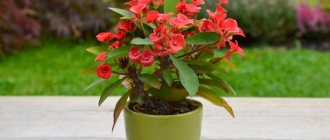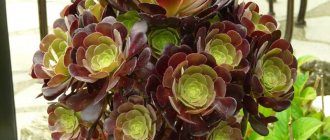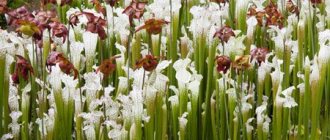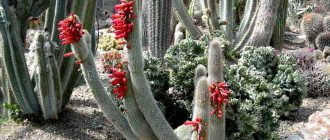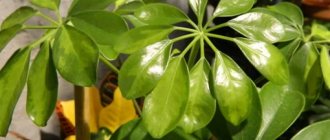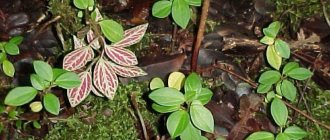Description and features of milkweed
The plant is classified as a member of the Euphorbiaceae family, which has over 1,500 species. On the territory of Russia alone there are about 150 varieties of milkweed. In appearance, they are very different from each other and can look like small trees, annual herbs or perennial cactus-like shrubs, but they all have one thing in common, namely the presence of a caustic white sap, similar to milk. This genus of plants owes its name to him.
Answering the question of whether spurge is poisonous or not - yes, many of its varieties are very toxic, but this in no way spoils their reputation as beautiful and undemanding indoor flowers. In addition, the beneficial properties of the plant are widely known. In pharmacology and folk medicine, all parts of this plant are used, including the root and flowers.
Types of indoor milkweed
The variety of species of milkweed, as well as their ease of care, have made them popular among gardeners around the world. Euphorbia is resistant to various temperature conditions and does not require abundant watering, and the spectacular appearance of this indoor plant becomes an additional argument in favor of decorating the interior of an apartment with it.
The table below shows the most popular varieties of indoor milkweed.
| Name | Peculiarities | Toxicity | |
| Belozhilkovy | Euphorbia leuconeura | Fleshy, bright green leaf blades with white veins on the front side. | Yes |
| Ribbed (comb) | Euphorbia lophogona | The outer side of the leaf has light green veins. The stem is covered with spiny shoots. | |
| mile | Euphorbia milii | It has a gray tuberous stem and small red, orange, crimson and yellow flowers. | Yes |
| Triangular (triangular) | Euphorbia trigona | The vertical shoots have many brown thorns and small spade-shaped leaves. | Yes |
| Beautiful (poinsettia) | Euphorbia pulcherrima | It has bright red bracts similar to leaves. Blooms in December. | Yes |
| "Head of Medusa" | Euphorbia caput-medusae | Horizontal gray-green lumpy shoots, similar to intertwined snakes. | Yes |
| Fat | Euphorbia obesa | The spherical shape resembles a cactus. | Yes |
Home care
To the deepest joy of many gardeners, we hasten to inform you (in case you, of course, did not already know): milkweed is an undemanding plant to care for. And this is simply wonderful, because you can grow any indoor plant species without fear for their subsequent existence.
Choosing a pot
It is very important to choose the right container when planting and replanting a plant. For milkweed, a shallow clay pot is the ideal solution. If you don’t have a clay one at hand, you can also use a plastic one, but again, not deep, since the root system of the plant is weak and superficial.
You should not immediately choose a larger container; it is enough if the pot is 2–3 cm larger in diameter than the previous one. The main thing is that there are good drainage holes in the bottom of the planting container.
When using a plastic pot, you need to place several large stones on its bottom so that an adult plant does not tip over the pot with its weight.
Choosing a place for milkweed
Euphorbia is truly one of the most unique indoor plants in terms of its parameters. It turns out that this flower is one of the few among those who are not afraid of direct sunlight.
Attention! Euphorbia can be safely grown on windows on the south side of the house. For some species of this plant, a large amount of sunlight is considered an excellent opportunity to preserve the true bright green color of the leaves.
In addition to lighting, it is necessary to take into account the degree of ventilation of the apartment. For example, milkweed extremely dislikes drafts. Also, the plant does not like too high a moisture level in the room.
Lighting
Bright lighting in both winter and summer. Euphorbias love a lot of light, but you need to gradually accustom them to direct sun in the spring and summer so that they do not get burned. The best place for milkweed is the windowsill of a south or southeast window. Make sure that there is enough lighting in winter; if necessary, provide additional lighting with fluorescent or LED lamps.
Some types of milkweed grow quite large at home and no longer fit on the windowsill; in this case, they need to be placed near the window, without shading or with additional lighting. All types of milkweed, similar to cacti with thick fleshy stems, are extremely photophilous; they need direct sun. And some, like white-veined or triangular milkweed, are relatively shade-tolerant, but grow best when they see the sun in the morning or evening.
Temperature
The most suitable temperature for the plant is 18–20C.
Euphorbia is particularly resistant to unfavorable external conditions, therefore, it can withstand lower temperatures, but not less than +5C.
In summer, the plant can be taken outside, but when it gets cool outside and the thermometer drops to 15C, it is better to bring the plant into the house.
Watering
There is one rule - the smaller the plant is similar in appearance to a cactus, the more it needs to be watered. Similarly, we need to look at the status of the soil. Abundant watering is done only after the soil has dried deeply. You must not allow moisture to stagnate in the substrate or allow it to sour. This applies most of all to those euphorbias that have a fleshy, full stem that can rot extremely quickly. But we should not forget that certain species respond extremely negatively to drying out of the soil clod, for example, Mil’s milkweed. They may respond by dropping leaves.
In winter, when kept cool, you should water significantly less, since during this period there is an even greater danger of rot occurring on the root system, as well as on the root collar.
Soil and fertilizers
For milkweed, you can purchase soil in special flower shops. Euphorbia soil is suitable for succulents or cacti. At the same time, professional flower growers prefer to prepare the soil with their own hands.
For preparation you will need the following ingredients:
- Soddy soil;
- Sand;
- Humus from leaves.
All ingredients are taken in equal proportions. It is also necessary to make a drainage layer. Small pebbles, polystyrene foam or expanded clay can be used as drainage. Drainage is required to ensure that water does not stagnate in the ground. This threatens to rot the plant’s root system.
Despite its general simplicity, it still needs feeding. Typically, fertilizers are applied once every two weeks during the vegetative growth period. As fertilizers, it is allowed to use fertilizers intended for succulent crops, as well as cacti. Flowering milkweeds require fertilization with a percentage of potassium. In the autumn and winter, no additional fertilizing is required.
Trimming
Certain varieties of milkweed (multiflorous, brilliant, Euphorbia Mila) require annual pruning. It is recommended to get rid of leaves that have grown over the winter in June or July, after flowering has ended. First, carefully inspect the bush, and then remove the dried stems using garden shears. There is no need to trim powerful shoots, because they will delight you with colorful flowers in subsequent years.
They can only be plucked off if you want to turn your euphorbia into a fairly dense bush. Professional flower growers recommend pruning renewal shoots in early spring. Keep in mind that after pruning, euphorbia will not bloom, and the result of the procedures performed will be visible only after a year.
Transfer
It is advisable to replant young milkweeds annually, each time placing the plant in a slightly larger pot. Adult plants are replanted once every three to four years or as needed. To do this, organize a new container, on the bottom of which a thick layer of drainage is placed.
Next, the substrate is poured, its mixture depends on the type of milkweed. For spiny plants and cactus-like plants, use succulent soil. Decorative foliage, as well as flowering representatives, can be planted in universal soil.
Before replanting, it is advisable to water the plant well so that it can be easily removed from the old pot. The soil is crumbled a little, but only so as not to spoil the root system. After which, the spurge is placed in a new pot and sprinkled with fresh substrate. The transplantation process is usually carried out in the spring.
But if root rot or disease is detected, the plant must be replanted on the same day, completely changing the entire composition.
What is the use of spurge and what does it treat?
The beneficial properties of milkweed have been used as a medicine since ancient times in many countries of the world, in particular on the African continent. It is actively used in both traditional and alternative medicine in the treatment of a wide range of diseases. Euphorbia has proven its benefits for people suffering from peptic ulcers and disorders of the gastrointestinal tract. It is also an effective remedy for constipation.
The juice of the plant has diuretic and anthelmintic properties, and therefore compositions based on it have a deep cleansing effect on the body and remove harmful toxins and wastes. In addition, milkweed juice helps reduce swelling and accelerate the healing of abrasions and burns. It effectively gets rid of warts and other skin lesions.
The antibacterial properties of beneficial resins and tannins of milkweed are often used to prevent diseases of the upper respiratory tract. Flavonoids in the plant successfully regulate liver function, eliminating harmful breakdown products of nutrients. A large amount of selenium has a beneficial effect on the elasticity of blood vessels and normalizes the functioning of the musculoskeletal system.
Euphorbia brings considerable benefits to the body of men. With its help, inflammatory processes of the genitourinary system and erectile dysfunction are treated. In addition, it is able to enhance libido and increase male potency.
Diseases and pests, control methods
With improper watering, lack of lighting and non-compliance with temperature conditions, milkweed becomes susceptible to various diseases and pest invasions. Fungal infections (root and gray rot, powdery mildew) become a common problem. If infected, the plant must be removed from the pot and damaged parts removed. Treat with a fungicide (for example, Fitosporin) and replant into a fresh substrate. To prevent re-infestation by fungi, you need to regulate the care of milkweed.
Plant pests:
- mealybug;
- scale insect;
- aphid;
- spider mite
At the initial stage of infection, you can treat the bush with a soap solution. In serious cases, it is better to use insecticides:
- Aktara,
- Fitoverm,
- Decis,
- Karbofos,
- Aktellik and others.
Traditional medicine recipes based on milkweed
Euphorbia has long established itself as a medicinal product, and since it is found in the home of almost every flower lover, they often try to benefit from it and make a healing composition based on it at home.
Euphorbia juice
Euphorbia juice is perhaps the most valuable component of this plant. The drug euphorbium is made from it, which is used in the treatment of a number of ailments, and is also used as an emetic and laxative. Despite its toxicity, in ancient times it was used to treat warts, calluses, lichen, eczema and other skin diseases. The bleaching properties of the juice were used to remove freckles.
Decoctions of leaves and stems of milkweed
The benefit of milkweed decoctions lies in the calming effect they have on the nervous system. However, in order for the decoction not to cause harm to health, you need to be able to prepare it correctly. For this it is necessary.
- Pour 5 g of leaves and stems into 0.5 liters of water.
- Boil for 10 minutes over medium heat.
- Use 1 tbsp. l. twice a day before meals.
Tea made from milkweed leaves and stems
We recommend reading: Tea with thyme: beneficial properties and contraindications
For kidney diseases, cystitis and hemorrhoids, tea from the leaves and stems of milkweed is beneficial. Its healing properties are used in the complex treatment of anemia and impotence. To prepare tea you should:
- Boil the plant material for 20 minutes to get rid of harmful plant compounds.
- Squeeze out the raw materials thoroughly and then dry.
- Grind the plant parts into powder.
- Dissolve the mixture in water or tea.
- Take 1 tbsp. l. per day after meals.
We recommend reading: Mint tea: beneficial properties and contraindications, how to make
Euphorbia root tincture
Since euphorbia has anti-inflammatory properties and suppresses the development of tumors, tincture from its root is often used as an adjuvant for cancer of the gastrointestinal tract and uterine fibroids. To make an alcohol tincture at home, you need:
- Pour 10 g of crushed plant roots into 500 ml of vodka.
- Leave the composition in a dark, cool place and let it brew for 10 - 14 days.
- Take the tincture for a month, 15 drops 3 times a day, gradually increasing the dose to 30 drops. Then, over the course of another month, gradually reduce the dosage to the original 15 drops.
For particularly complex forms of disease, the course of taking the tincture can be increased to 3 - 5 months. To avoid harm to health, it is important not to exceed the recommended dosage.
Milkweed seed oil
Many people know about the beneficial properties of castor oil. However, few people know that it is extracted from the seeds of a plant of the euphorbia family, which is called castor bean. Castor oil has long been well established as a substance that helps heal cuts, wounds and boils. It is used in inhalations for bronchitis, tuberculosis and other lung diseases. But cosmetics manufacturers derive the greatest benefit from this oil, since its properties help accelerate the growth of hair and nails, give them strength and heal the scalp. For these reasons, milkweed oil is added to shampoos, creams, soaps, masks and other beauty products. It also serves as an ingredient in many homemade beauty recipes.
- Anti-wrinkle mask. To eliminate wrinkles, mix equal parts of castor, olive and peach oils. Heat the mixture in a water bath and lubricate the skin in the wrinkle area. After 15 minutes, rinse with water at room temperature. The procedure is repeated twice a day.
- Mask for dry skin. A mixture of castor and peach oils is combined in a ratio of 1 to 2 and the composition is used as a cream daily.
- To soften calluses. Apply the oil to your feet overnight and put on socks. The procedure is repeated three times a week.
Benefits of milkweed honey
The benefits of milkweed flowers are manifested in their honey-bearing properties. Fresh honey from this plant is a brown mass, similar in consistency to syrup. Over time, it hardens and acquires a dense, thick texture. This honey owes its dark hue to its high iodine content, which makes it especially useful if a person has problems with the thyroid gland. In addition, the benefits of milkweed honey are that it increases the body's defenses and helps fight infections and harmful microorganisms. The beneficial properties of milkweed honey also apply to people with diseases of the cardiovascular system, chronic fatigue, and insomnia.
Why is spurge dangerous?
Although milkweed is a unique houseplant with many benefits, it can cause serious harm to humans as many of its parts are toxic. In this regard, preparations based on milkweed are prohibited from being taken by the following groups of people:
- children;
- pregnant women;
- nursing mothers;
- for allergy sufferers;
- those suffering from plant intolerance;
- with diseases of the cardiovascular system.
Healthy people should also be careful when handling milkweed. If milkweed-based formulations are used incorrectly or the conditions of its maintenance in the apartment are violated, all the benefits of the plant can result in harm to the body. So, this plant can cause chemical burns or serious poisoning.
Skin burn
Being a very poisonous plant, spurge, in particular its juice, has an aggressive effect on the skin, causing a chemical burn, which is accompanied by severe pain and profuse rashes.
If the milky sap of the plant comes into contact with the skin, you must immediately rinse the affected area of skin with plenty of clean water, and then cover the burned area with ice to reduce pain.
Important! In some cases, such a burn can provoke a severe allergic reaction. To prevent symptoms, the victim should be given an antihistamine.
Getting milkweed juice in your eyes
The milky sap of a plant, in particular milkweed, can cause very serious harm to health if it comes into contact with the eyes. If this happens, you should immediately rinse the affected eye with running water or chamomile decoction to completely wash away the toxic milkweed liquid, and then immediately seek medical help. To speed up the diagnostic and treatment procedure, it is advisable to present the doctor with a sample of the plant that caused the burn.
The severity of eye damage varies depending on the variety of milkweed. Burns of this kind are characterized by the following symptoms:
- burning;
- pain;
- photophobia;
- lacrimation;
- swelling of the eyelids;
- blurred vision.
Important! If the plant juice gets into your eyes, you should absolutely not self-medicate and put off visiting a doctor! Delay can have a harmful effect on the cornea of the eyes, leading to partial or complete blindness.
Milkweed juice poisoning
Poisoning with milkweed juice occurs when toxic liquids from the plant enter the body. An increased risk of intoxication occurs in the following situations:
- Weeding. Many plants of the Euphorbiaceae family are classified as weeds, due to their ability to grow wildly on almost any soil.
- Caring for your home flower. Most of the indoor milkweed species so beloved by gardeners have poisonous properties.
- Making medicinal compositions based on plants at home. Exceeding the dosage when using decoctions and tinctures, for example, based on white-veined milkweed, can cause extensive harm to the entire body instead of benefit.
- Games with plant parts. Poisoning often occurs in children if the toxic flower is within the child’s reach.
When a person takes concentrated milkweed juice or eats plant materials within 6 - 12 hours, signs of poisoning appear, including:
- dizziness;
- headache;
- nausea;
- burning in the throat;
- sharp pain in the abdominal area;
- vomit;
- diarrhea;
- dehydration of the body.
As soon as the toxic substances of the plant are completely absorbed into the blood, the victim’s body temperature rises, consciousness becomes confused, convulsions and loss of orientation are observed. Without timely action, a coma is likely.
Growing conditions
Since there are many varieties of homemade milkweed, care rules may have nuances depending on the specific species . Most representatives of indoor milkweed are succulents or related species, so general recommendations apply specifically to succulent milkweed.
Air temperature and humidity
The optimal temperature for good growth and development is 20-25 degrees (during the dormant period it should be reduced to 14). Even if the room is too warm, drafts should not be allowed. It is better not to place spurge next to windows that are opened for ventilation.
Humidity does not matter for milkweed: it feels equally good at high, medium, and low humidity.
Where does it grow best?
Euphorbia loves light very much and therefore needs long daylight hours and feels good on window sills or other surfaces close to the window.
But if direct sunlight falls on it for a long time, it may get burned, so you should not place it in front of those windows into which the sun shines directly. In these cases, the plant should be shaded.
In winter, it needs artificial lighting even during hibernation . With a lack of light, at best it stops growing, at worst it withers and dies.
In summer, milkweed can be taken out onto the balcony or into the garden, but in this case you need to monitor precipitation and wind: this plant does not tolerate either of these. At the same time, in calm weather it feels good outside.
First aid for poisoning
If milkweed juice does get into your body, you need to call an ambulance immediately! Before the doctors arrive you should:
- Lay the victim on the bed and try to provide him with physical rest.
- Ensure cleansing of the body from harmful compounds by offering the patient 100 g of activated carbon 80 - 100 g or a saline laxative.
- Give the patient alkaline mineral water, milk or jelly to drink to reduce the harm from toxic substances to the stomach.
Important! Do not touch the skin with hands stained with plant juice.
Signs and superstitions associated with milkweed
In addition to healing properties, milkweed is also credited with magical properties. Thus, followers of Feng Shui do not recommend placing thorny representatives of this family of plants in the bedroom, so as not to provoke discord and quarrels in the relationship of spouses or lovers. A better place would be a computer desk, where the spurge will absorb negative energy associated with work and financial matters.
In addition, there is a belief that the plant attracts good luck in the professional sphere and promotes career advancement. It also has the property of “luring” money and protects its owner from the harmful effects of evil forces and the evil eye.
Where is the best place not to place milkweed?
Euphorbia is a fairly unpretentious plant, caring for which does not cause much trouble even for novice gardeners. Despite its tropical origin, it tolerates the conditions of a temperate climate zone quite well. This plant feels great in rooms with good lighting without drafts at a temperature of 18 - 20 ° C.
However, when choosing a place for a pot of milkweed, lovers of this plant should take into account its toxic properties. In many species of milkweed, not only the juice, but also the leaves and stems have a harmful effect, so it is very important that the plant is never placed in places accessible to children.
If there are animals in the house, it is also worth restricting their access to the room where the spurge is located, since pets, especially cats, have the habit of chewing green spaces and can cause harm to themselves, even death.
If it is not possible to dissuade the animal from a pot with a flower, you may need to refuse to purchase such a plant in order to avoid possible harm.
Harvesting the plant
In folk medicine, benefits are not derived from the entire green mass of the plant, but only from the milky sap and rhizome of the plant. After squeezing the juice, it is continued to evaporate in a water bath, after which it is poured into sealed containers.
To keep the juice pure and prevent it from turning into poison, you need to fill the juice with a thin layer of melted lamb fat before sealing the sterile container. After which all containers are stored at almost zero temperature no higher than +5 degrees Celsius.
The roots are harvested in early spring before the beginning of the growing season of the green mass of the plant or in late autumn after the leaves fall. The dug out parts of the roots are washed well with running water and sent to dry in special drying cabinets, where they are dried at a temperature of 40 degrees.
To obtain juice, all parts of the flower are cut off during the flowering period and then the juice is carefully squeezed out of them. It is very rare that milkweed flowers themselves are collected. They are dried under a canopy in the shade, after which they are poured into a container for bulk products and stored in the refrigerator.
Actually, here's everything you need to know about this beautiful flower. It is not whimsical and is in deserved demand among lovers of office flowers. And the exotic appearance speaks for itself, so you can always choose spurge to suit your taste.
Euphorbia triangular
Read about different types of lawns here.
Precautions when caring for milkweed
Caring for indoor milkweed is quite easy, as it does not require much attention. However, it is worth following certain safety measures to protect yourself from the harmful effects of the plant.
- Pruning, replanting and other garden work should be carried out wearing thick protective gloves. They must certainly be rubber, since harmful plant toxins can penetrate the skin through the fabric.
- Even if you are wearing gloves, you need to thoroughly wash your hands with soap every time you come into contact with the plant.
- Additional protective equipment should not be neglected: such as glasses and a mouth mask. Even with the safest, at first glance, procedure, there is a possibility of damaging the plant, after which milkweed juice from gloves can get on the mucous membranes of the eyes or mouth.
- We must also remember to wash the tools immediately after pruning and replanting the plant.
- It is important to keep children and animals away from milkweed.
Reproduction methods
Cuttings
Cut a shoot 10 cm long and remove the lower leaves. Thoroughly rinse off the juice on the cut with running water and treat the area with charcoal. When the cut dries a little, the shoot should be placed in a pot with wet sand.
Cover the top with a film with several air holes (or a transparent cap), leave until the plant takes root, then transplant into a pot with regular soil. It is important that the sand is always moist and that the sprout is not exposed to sunlight.
Seeds
Most species of milkweed are dioecious . This means that for reproduction you will need two copies: male and female. Euphorbia is not a self-pollinating plant, so you will have to carry out artificial pollination yourself during flowering.
- Mature pollinated seeds need to be collected (usually this happens in the fall) and distributed over a mixture of sand and peat (1:1 ratio), like ordinary garden seedlings.
- Moisten the soil, cover with glass and place in a warm place.
- When the sprouts sprout, the glass can be removed.
- As soon as the first sufficiently developed leaves appear, it is time to plant the seedlings in separate pots with the usual soil for adult plants.
Dividing the root
It is rarely used and not for all species (for example, spurge spurge tolerates this method of propagation well, but some species, especially single-stemmed ones, may die).
- At the end of spring or beginning of autumn, you need to remove the plant from the pot, carefully shake off the soil from the roots, cut off rotten and dry areas.
- Separate the stems along with the roots that belong to them (carefully tear them apart with your hands, and do not cut them), treat the breaks with charcoal.
- Then plant all the bushes in different pots with moist soil and place them in a bright but shaded place until they settle in and recover.
- They can then be moved to bright light.
This method of propagation is undesirable, since spurge does not tolerate it well.
During the first year after division, all the bushes involved in the process will grow poorly and bloom little or not bloom at all.
To help in recovery, you need to care for the plant especially carefully, without skipping watering and fertilizing, making sure there is sufficient lighting for a long time every day.

